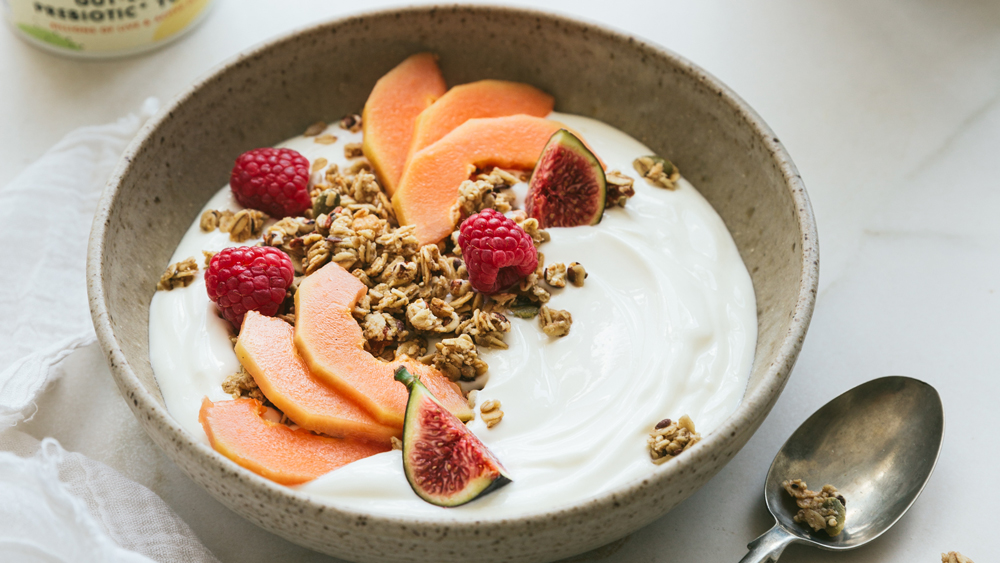The Gut Health Doctor Explains Prebiotics
What to feed the good bacteria in your gut

There’s no easy way to put this. There are millions of microscopic living things residing in your gut and it is absolutely essential to your wellbeing that you keep them well fed. “Gut bacteria are central to overall health and happiness,” says Dr Megan Rossi, a dietitian and research fellow at King’s College London, who helps the public gain a better and scientifically valid understanding of the gut microbiome under the moniker of the Gut Health Doctor. “The way in which we nourish this inner community living in our gut is key.”
As well as publishing a book, Eat Yourself Healthy, Rossi has launched her own range of gut-boosting foods called Bio&Me. The latest product is a prebiotic yogurt, available at Sainsbury’s.
We asked Rossi to explain prebiotics, and in the course of the conversation also learned how to improve our gut health without resorting to fad diets or expensive supplements.
What is a prebiotic and how does it differ from a probiotic?
Although there’s only one letter difference between them, prebiotics and probiotics are very different things! Prebiotics are essentially food for the good gut bacteria.
We generally get our prebiotics from plant-based foods. There are some foods that are naturally higher in prebiotics, such as garlic, onion and leeks, but instead of fixating on getting your prebiotics, if you eat a really diverse range of plant-based foods you’re going to be getting sufficient prebiotics.
In my clinical practice I very rarely recommend a prebiotic supplement – I just say eat a diverse range of plants. Our “30 Plant Point Challenge” aims to get people eating 30 different types of plants in their diet per week, which is actually much easier than it sounds. That will ensure you have plenty of prebiotics to “fertilise” your bacteria.
Probiotics essentially are the live beneficial microbes that live in the gut. There are thousands of different types of bacteria, although in fact some probiotics are types of yeast. Research is now coming out which shows that each one does different things.
Get the Coach Newsletter
Sign up for workout ideas, training advice, reviews of the latest gear and more.
Talking therapeutically, if someone has been on antibiotics for example, I will prescribe them a specific probiotic that has been shown to prevent some of the side effects of the antibiotic. Similarly, with immune function, if people are constantly getting ill with the common cold or flu, then there are specific probiotics that can help with that – I list them in my book, Eat Yourself Healthy.
What are the benefits of Bio&Me yogurt? Is it a probiotic as well as a prebiotic?
In the UK and Europe we can’t use the word probiotic, it’s not an EFSA [European Food Safety Authority] approved word for food products. We can only call them “live and active cultures”.
Among the 18 types of live and active cultures in Bio&Me yogurt are two of the most clinically-trialled strains. There are so many studies supporting their use.
However, we can call it a prebiotic, because we’ve added in a specific food for the gut bacteria: chicory root fibre. No other yogurt is a prebiotic. There are so many yogurts that say they promote gut health, but none of them are in line with what the science is saying. Some have artificial sweeteners in them, or heaps of added sugar. Some have emulsifiers and thickeners, and other extra ingredients which actually we don’t think are great for the gut.
What exactly is chicory root fibre and who can benefit from including it in their diet?
There’s a wealth of studies looking at chicory root fibre (or chicory inulin). It’s one of the most well-studied prebiotics, and it’s been proven to help increase the number of beneficial bacteria in the gut, specifically bifida bacteria, which people are starting to hear more about. The EFSA regulators have approved it because there’s a wealth of evidence saying that it can help improve the frequency of your bowel movements. So that’s one of the really basic benefits. But the benefits that I get really excited about is that it feeds the good bacteria in our gut.
Should people with IBS steer clear of these types of prebiotics?
IBS is one of the main things I see in my clinic and there are different severities. Most of my patients can tolerate small amounts of prebiotics, like inulin, and I encourage them to include prebiotics in their diet because we know they have a health benefit.
If someone’s got really bad IBS I will put them on this short-term diet called a low-FODMAP diet in which we cut out all the prebiotics that feed the bacteria so the bacteria can have some chill time. That means they’re not fermenting away and producing gas, which when you’ve got a sensitive gut lining that can really aggravate the gut symptoms. It’s not a healthy diet, and if you’re on it too long some of your beneficial bacteria will decrease as well, so we do it for a maximum of eight weeks and then slowly and systematically reintroduce these foods.
For those with IBS or a sensitive gut it’s really about training your gut, so I would get them to stick to 50g of the prebiotic yogurt a day for the first two weeks and then move up to 100g. You don’t want your bacteria to binge and produce a load of gas, so it’s important to introduce small amounts at first so they learn to metabolise that.
What does it mean to have a healthy gut?
That’s the million-dollar question! We are just starting to uncover how important the gut is, and therefore what good gut health really means. I guess what gut health looks like is really smooth digestion – not having any gut symptoms – but it also goes way beyond that.
If you don’t have a good gut lining you can’t digest your food effectively. Then there’s the immune system element: 70% of our immune cells live in the gut. People who have good gut health also have strong immune systems.
The third element is to do with the trillions of bacteria that live along that digestive tract. It’s these bacteria that we’re still learning about, and they are changing our perception of what it means to be human. There are a lot of functions that we thought the human body itself was responsible for, such as producing certain hormones and vitamins, but it turns out these functions are actually performed by bacteria. These bacteria have also been linked to the prevention of heart disease, mental health issues, obesity, liver disease and kidney disease. In this way, it seems that the gut bacteria are central to our overall health and happiness.
- 5 gut health myths according to the Gut Health Doctor
- How gut health is linked to your mental health
- Improve your diet with these foods that are good for your gut
How do you know if your gut is not in good health?
This is the question I get asked the most, and sadly there’s no simple tool to assess gut health yet, as the gut is so complex and our understanding of it is still in its infancy.
When I was writing my book, I reviewed the research and pulled together this 10-question assessment which helps people grade their gut health from 0-20. It also gets people thinking about all the different factors that can have an impact on gut health.
Once a person has got their initial score they can then begin to change some aspects of their life and see if their score improves. It helps people quantify gut health and gives them a tangible outcome to aim for.
Do you have any tips for improving your gut health in other ways?
It’s really important that people appreciate that gut health is not just about diet, because you can have the most perfect diet but if you’re not sleeping, you’re stressed and you’re not moving your body, then you’re not going to have great gut health.
Getting seven to nine hours of sleep a night helps, as does five or ten minutes of breathing or mindfulness exercises per day.. Exercise is important – it doesn’t need to be going to the gym, but just going for a brisk walk for at least 30 minutes can improve the health of your gut bacteria.
The key concept for me is that gut health is obtainable. You don’t need to buy crazy expensive supplements and be on a restrictive diet – it’s more about what you’re including than what you’re excluding.

Camilla Artault is a writer and keen runner. She has covered women’s running gear – testing leggings, jackets, running bras, tops and shorts – for Coach since 2018, as well as interviewing experts and writing about a range of health and lifestyle topics.









